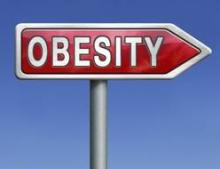The prevalence of obesity has not changed appreciably among children or adults in the United States between 2003 and 2012, the most recent year for which data are available, according to a report published online Feb. 25 in JAMA.
Obesity prevalence was high at 16.9% among children and 34.9% among adults in 2011-2012, which does not differ significantly from the rates of 17.1% and 32.2%, respectively, in 2003-2004, said Cynthia L. Ogden, Ph.D., of the National Center for Health Statistics (NCHS), and her associates.
They analyzed data from the National Health and Nutrition Examination Survey (NHANES), a nationally representative sample of the general U.S. population, to obtain the most recent estimates of obesity and to track any trends that may have occurred between the two time periods. The investigators focused on the records for 9,120 people aged 2 years and older who participated in the 2011-2012 NHANES.
For children aged 2-19 years in that survey, the prevalence of overweight or obesity was 31.8% and that of obesity alone was 16.9%, with no differences between boys and girls.
When the data were broken down by pediatric age groups, the rate of obesity was 8.4% in 2- to 5-year-olds, 17.7% in 6- to 11-year-olds, and 20.5% in 12- to 19-year-olds. There were no significant changes between this survey and the one in 2003-2004 except that the prevalence of obesity in the 2- to 5-year-old age group declined by 5 percentage points over time, the researchers said (JAMA 2014;311:806-14 [doi:10.1001/jama.2014.732]).
Among adults in the most recent survey, 68.5% were either overweight or obese; 34.9% were obese, and 6.4% were extremely obese. Again, there were no significant changes between this survey and the one in 2003-2004 except for an increase of 4 percentage points in obesity among women aged 60 and older. The NCHS released these data in 2012 (NCHS Data Brief January 2013).
"Obesity prevalence remains high, and thus it is important to continue surveillance," Dr. Ogden and her associates said.


